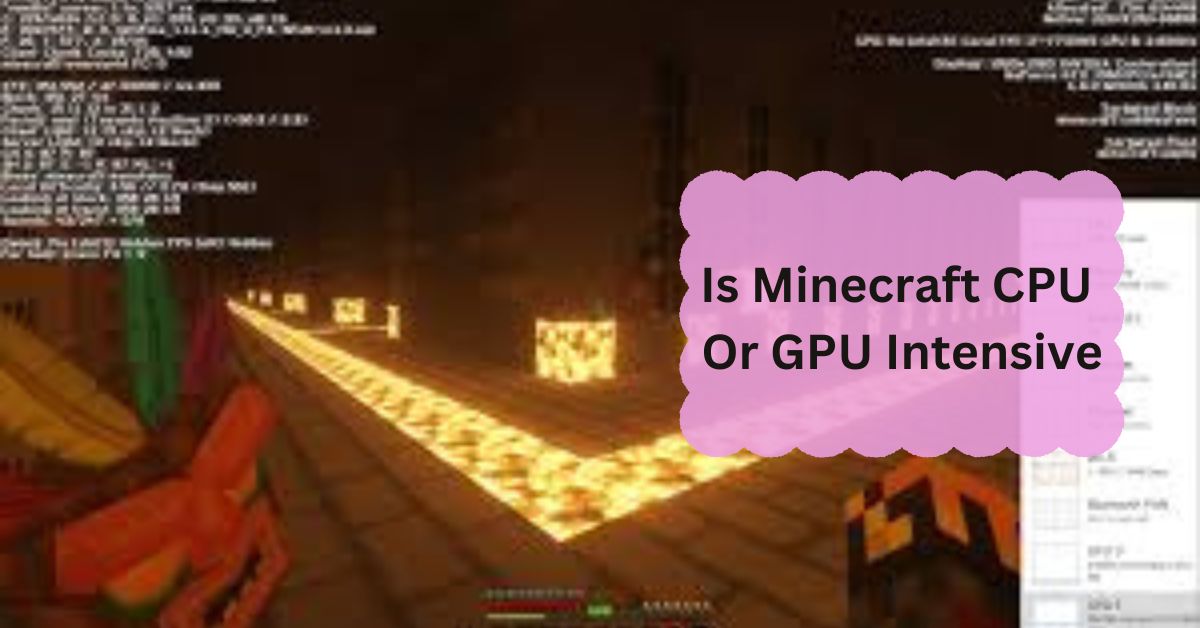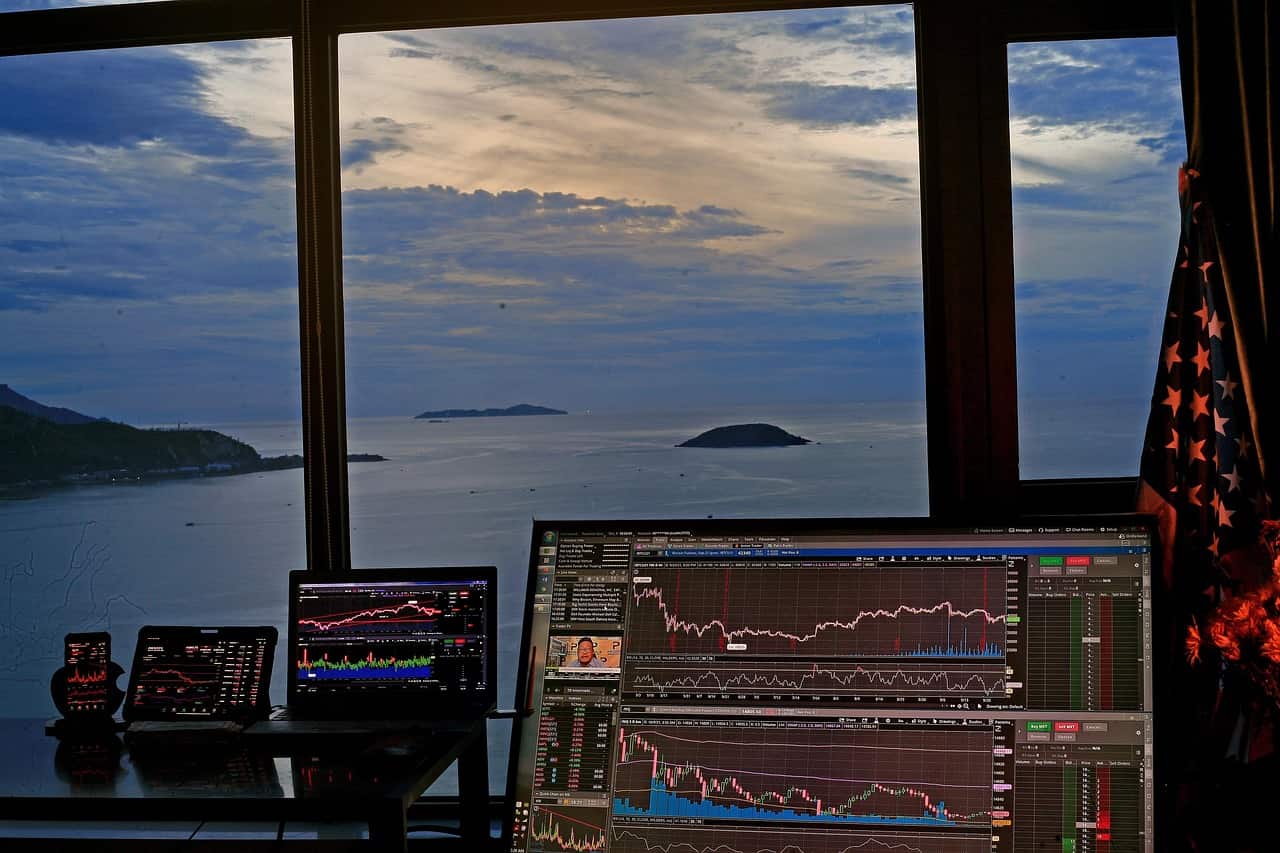Minecraft is one of the most popular games in the world, known for its blocky graphics and endless possibilities. However, Minecraft is more demanding on the CPU or the GPU when it comes to performance.
Minecraft is more CPU-intensive than GPU-intensive. The game needs a strong CPU to handle tasks like world generation and game mechanics. However, a decent GPU is still important for rendering graphics smoothly, especially with mods or high settings.
In this article, we will discuss “Is Minecraft CPU Or GPU Intensive”.
Table of Contents
Understanding CPU and GPU Roles in Gaming:
Basic Functions of a CPU:
The CPU, or Central Processing Unit, is often referred to as the “brain” of the computer. It handles most of the game’s logic, such as calculating positions, managing AI, and processing inputs.
For games, a strong CPU can ensure smooth gameplay, especially in scenarios where many calculations are needed.
Basic Functions of a GPU:
The GPU, or Graphics Processing Unit, is responsible for rendering images and animations. In games, the GPU takes the data from the CPU and turns it into the visuals you see on the screen. A powerful GPU is essential for high-quality graphics and smooth frame rates.
How These Components Work Together in Gaming:
In gaming, the CPU and GPU work hand in hand. The CPU processes game logic and the GPU handles the visuals. Depending on the game, one of these components may be more heavily utilized than the other.
Minecraft’s Technical Requirements:
Overview of Minecraft’s System Requirements:
Minecraft’s system requirements are relatively modest compared to other modern games. However, these requirements can vary depending on how you play the game.
Minimum vs. Recommended System Requirements:
- Minimum Requirements: These allow the game to run at a basic level. Expect lower resolution and frame rates.
- Recommended Requirements: These provide a smoother experience with higher settings and better performance.
Is Minecraft CPU Intensive?
Analysis of Minecraft’s CPU Usage:
Minecraft is known to be quite CPU intensive, especially in scenarios involving large worlds, complex redstone machines, or multiple entities. The game’s logic, including block updates, mob AI, and physics, relies heavily on the CPU.
How Different Game Activities Impact CPU Load:
Certain activities, like exploring new chunks or using redstone contraptions, can significantly increase CPU usage. The more complex the task, the harder the CPU has to work.
Examples of CPU-Heavy Tasks in Minecraft:
- Exploring New Areas: When generating new terrain, the CPU is tasked with creating and loading chunks.
- Redstone Machines: Complex redstone circuits require the CPU to constantly update and process interactions.
- Mob Farms: Managing large numbers of entities can be demanding on the CPU.
Is Minecraft GPU Intensive?
Analysis of Minecraft’s GPU Usage:
While Minecraft is more reliant on the CPU, the GPU still plays a critical role, especially when using shaders or playing at higher resolutions. The blocky graphics may seem simple, but rendering large draw distances and detailed environments can be GPU-intensive.
How Different Game Activities Impact GPU Load:
Activities like playing with high-resolution textures, enabling shaders, or increasing the render distance can significantly stress the GPU.
Examples of GPU-Heavy Tasks in Minecraft:
- Using Shaders: Shaders can transform the look of Minecraft, but they require a lot of GPU power to run smoothly.
- High-Resolution Textures: Running texture packs that increase the resolution of blocks will demand more from the GPU.
- Maxing Out Render Distance: A higher render distance means the GPU has to work harder to display distant objects.
Comparing CPU and GPU Usage in Minecraft:
Typical CPU vs. GPU Usage in Minecraft:
In general, Minecraft leans more on the CPU than the GPU, particularly in standard gameplay without any modifications. However, adding mods or shaders can shift the burden more toward the GPU.
Which Component Tends to Be More Stressed:
For most players, the CPU is the bottleneck in Minecraft. But for those using high-end graphics enhancements, the GPU can become the limiting factor.
Impact of Mods on CPU and GPU Usage:
How Mods Can Increase CPU Usage:
Mods that add new mechanics, mobs, or complex systems can significantly increase CPU usage. This is especially true for mods that introduce new world generation or large amounts of entities.
How Mods Can Increase GPU Usage:
Graphic mods, like shaders or high-resolution texture packs, can push the GPU to its limits. These mods enhance the visual appeal of Minecraft but require much more graphical processing power.
Popular Mods That Affect CPU and GPU Performance:
- Optifine: Enhances performance and allows for the use of shaders.
- SEUS Shaders: Adds realistic lighting and shadows, which can be GPU-intensive.
- Biomes O’ Plenty: Adds new biomes, increasing world generation load on the CPU.
Minecraft’s Performance on Different Hardware:
Performance on Low-End Systems:
Minecraft can run on low-end systems but expect to lower the settings for playable performance. Reducing render distance and disabling fancy graphics can help.
Performance on Mid-Range Systems:
Mid-range systems can handle Minecraft with moderate settings, including some shaders and higher render distances, without major issues.
Performance on High-End Systems:
High-end systems can run Minecraft at maximum settings with no trouble, even when using demanding shaders and mods.
Optimizing Minecraft Performance:
Tips for Reducing CPU Load:
- Lower Render Distance: Reducing the number of chunks loaded at once can ease the burden on the CPU.
- Limit Entity Counts: Avoid large mob farms or areas with many entities.
- Simplify Redstone Machines: Complex Redstone builds can be optimized to reduce CPU strain.
Tips for Reducing GPU Load:
- Disable Shaders: If performance is an issue, disabling shaders can significantly improve frame rates.
- Lower Resolution: Playing at a lower resolution will reduce the demand on the GPU.
- Adjust Graphics Settings: Tweaking settings like smooth lighting and fancy graphics can balance performance.
Best Settings for a Balanced Performance:
- Render Distance: 8-12 chunks.
- Graphics: Fast.
- Smooth Lighting: Off or Minimum.
- Entity Shadows: Off.
The Role of Optifine in Performance:
What Is Optifine?
Optifine is a popular optimization mod for Minecraft that improves performance, allows for HD textures, and adds new graphics options.
How Optifine Helps Reduce CPU and GPU Usage:
Optifine optimizes Minecraft’s code, making it more efficient and reducing the load on both the CPU and GPU. It also offers settings to adjust graphics quality for better performance.
Recommended Optifine Settings:
- Render Distance: 8-12 chunks.
- Graphics: Fast or Fancy.
- Dynamic Lighting: Fast.
- Performance: Set to “Max FPS” for the best results.
Does Ray Tracing Affect CPU or GPU More?
Explanation of Ray Tracing in Minecraft:
Ray tracing is a graphical technique that simulates the way light interacts with objects in a realistic manner. It’s available in the Bedrock Edition for players with compatible hardware.
Impact of Ray Tracing on CPU Usage:
Ray tracing is mostly GPU intensive, but it can also increase CPU usage due to the additional calculations required for lighting and reflections.
Impact of Ray Tracing on GPU Usage:
Ray tracing is extremely demanding on the GPU, requiring a powerful graphics card to run smoothly. The GPU handles the complex calculations needed to render realistic lighting and shadows.
Choosing the Right Hardware for Minecraft:
Ideal CPU Specifications:
For the best experience, look for a CPU with a high clock speed and good single-core performance, such as the Intel Core i5 or AMD Ryzen 5.
Ideal GPU Specifications:
A mid-range GPU like the Nvidia GTX 1660 or AMD Radeon RX 580 is suitable for most players. For ray tracing, a Nvidia RTX 2060 or higher is recommended.
Recommended Configurations for Different Budgets:
- Budget Build: Intel Core i3 or AMD Ryzen 3, GTX 1050 Ti.
- Mid-Range Build: Intel Core i5 or AMD Ryzen 5, GTX 1660.
- High-End Build: Intel Core i7 or AMD Ryzen 7, RTX 2070 or higher.
Minecraft Java vs. Bedrock Edition Performance:
Differences in Performance Between the Two Editions:
Java Edition is known for its modding community and flexibility, but it can be more demanding on hardware. Bedrock Edition is more optimized and generally runs better on a wider range of systems.
CPU and GPU Usage Comparison:
Java Edition tends to be more CPU-intensive, while Bedrock Edition is better optimized for GPUs, especially on consoles and mobile devices.
Should I Run Minecraft On CPU or GPU?
Run Minecraft on your GPU. It handles graphics better, giving smoother gameplay. The CPU handles general tasks, but the GPU improves visuals and performance, especially for higher settings.
Does Minecraft Use 100% GPU?
Minecraft usually doesn’t use 100% of your GPU. It depends on your settings and mods. High settings or heavy mods might increase GPU usage, but rarely to full capacity.
Is Minecraft Server CPU or RAM Intensive?
Minecraft servers are more CPU-intensive. They need strong CPUs to handle multiple players and tasks. RAM is also important but less critical than a powerful CPU for smooth server performance.
How much of your GPU does Minecraft use?
Minecraft’s GPU usage varies based on settings and mods. On average, it uses a moderate amount, but it can increase with higher settings, shaders, or many mods.
Does Minecraft use more CPU or GPU?
Minecraft uses more CPU for tasks like world generation and redstone circuits. The GPU is used for rendering graphics. For smooth gameplay, both should be balanced.
Is heavily modded MC more GPU or CPU-intensive?
Heavily modded Minecraft is usually more CPU-intensive. Complex mods add tasks that require more processing power. The GPU handles the extra graphics, but the CPU does most of the work.
Does GPU Increase FPS In Minecraft?
Yes, using a good GPU can increase FPS in Minecraft, especially with high settings or mods. The GPU handles graphics, so a stronger one improves frame rates.
How to Make Minecraft Use Your GPU?
To make Minecraft use your GPU, ensure your system settings prioritize the GPU. Set Minecraft’s graphics processor to the dedicated GPU in your system’s control panel.
Is Fortnite CPU or GPU-intensive?
Fortnite is more GPU-intensive for graphics but also needs a decent CPU for smooth gameplay. A good balance between both ensures better performance.
Is Roblox CPU or GPU Intensive?
Roblox is generally more CPU-intensive. It requires a decent CPU to handle physics and game logic. However, the GPU is also important for rendering graphics.
Is Valorant CPU or GPU Intensive?
Valorant is more CPU-intensive, focusing on processing game logic and physics. A strong CPU improves gameplay, but a decent GPU is still needed for smooth graphics.
Is Modded Minecraft CPU or GPU Intensive?
Modded Minecraft is more CPU-intensive. Mods add tasks and features that require more CPU power. A good CPU is essential for handling mods effectively.
Is Minecraft Bedrock CPU Or GPU-intensive?
Minecraft Bedrock is more GPU-intensive, focusing on smoother graphics and performance across devices. It’s optimized for GPUs but still needs a decent CPU.
Is Minecraft Shaders CPU Or GPU-intensive?
Minecraft shaders are GPU-intensive. They enhance graphics, requiring more GPU power for better visuals. A good GPU is essential for running shaders smoothly.
Best CPU for Minecraft?
The best CPU for Minecraft is one with a high single-core performance. Intel Core i5 or Ryzen 5 series are excellent choices, providing smooth gameplay even with mods.
FAQs:
What is the best CPU for Minecraft?
A CPU with good single-core performance, like the Intel Core i5 or AMD Ryzen 5, is ideal for Minecraft.
Does Minecraft need a powerful GPU?
Not necessarily. A mid-range GPU is sufficient for most players, but shaders and high settings will require a stronger GPU.
Can I play Minecraft on an integrated GPU?
Yes, but you may need to lower the settings for smooth performance, especially on older or less powerful integrated GPUs.
How do mods affect Minecraft’s performance?
Mods can increase both CPU and GPU usage, depending on the type. Performance mods like Optifine can help mitigate the impact.
Is Minecraft more demanding than other games?
Minecraft is less demanding than many modern AAA games, but it can still be challenging for lower-end systems, especially with mods and high settings.
Conclusion:
Minecraft is more CPU-intensive than GPU-intensive, especially for tasks like world generation and Redstone machines. However, a good GPU improves graphics, especially with shaders or high settings. To get the best performance, balance both the CPU and GPU. Mods can increase the usage of both, so optimize your settings accordingly for smooth gameplay.


